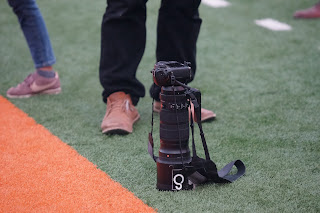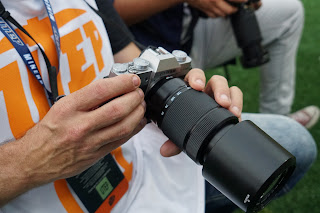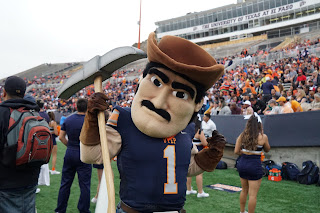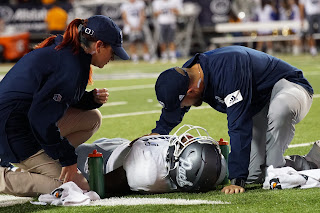I was on the sidelines of an NCAA Football game recently and took note of the gear that the professional sports photographers were using. *Spoiler alert...
The vast majority of professional photographers were shooting the game with Canon camera bodies and lenses. With the Canon 300mm f/2.8 being the predominant lens amongst the hardcore pros, and with good reason.
One of my coworkers was selected to be recognized by the University of Texas at El Paso as a "Hometown Hero". Sergeant First Class Richard Cortez Sr. is a 14 year veteran of the Field Artillery branch of the United States Army, with three combat deployments under his belt. I am proud to serve with him. In addition to this recognition by the University, he has also just made the promotion list for Master Sergeant. This is considered to be a career bench mark for Non-Commissioned Officers. At any rate, they were recognizing him at the game and I, as the Unit Public Affairs Representative, was on hand to capture the moment.
However, as this ceremony only lasted a few minutes, I had the rest of the game to take advantage of my press pass to roam the sidelines and capture not only the game action, but to take note of what kind of gear the professional photographers were using. This was after all a Division 1 NCAA football game and there were sure to be a number of professional sports photographers in attendance.
Above: My press pass and media parking pass. Oh the perks!
Below: My gear for the evening: (From L to R Sony A7II with Zeiss 16-35mm f/4 lens, Sony A6300 with Sony A Mount 70-300mm G f/4.5-5.6 lens, mounted via the Sony LA-EA3 adapter (more on this later) and a Sony A99 with the Sony 70-200mm f/2.8 lens
Above: I mounted my heaviest camera and lens combo on a monopod with a ball head, however, this relatively inexpensive brand of monopod was not able to handle the weight of my camera and lens and I eventually had to put it in my bag, thereafter relying on my Sony A6300 (Pictured below) with the Sony 70-300mm G lens which was strapped on a double shoulder harness.
As you can see in the photo below, it was an overcast day, the complete absence of any sunlight, combined with what one professional photographer told me was the worst stadium lighting in Division 1 college football, made for difficult photographic shooting conditions. As you may or may not know, sports photography generally requires fast shutter speeds in order to capture fast moving subjects. Less light, however, requires longer exposures to get enough light for a proper exposure, but since this generally isn't a viable option for sports photography, the only other choice is to bump up the ISO. But how high would I have to bump it up?
Keep in mind the lenses I was using; a f/4 wide angle lens, a f/4.5-5.6 zoom lens and a f/2.8 zoom lens. I found that I had no choice but to shoot at ISO 6400 with the slower lenses! I even had to shoot at ISO 2500 on my 2.8 lens, that's how bad the lighting was. One would think that a stadium with as rich a history and one that hosts one of the oldest Bowl Games in the country would sport a more robust lighting system. Unfortunately, the famed Sun Bowl at the University of Texas at El Paso only employs two modest banks of lights on the East and West sides of the field, that's it. They were of no help prior to sunset and only provide a sort of drab, dim lighting after it gets dark. It was bad and I found myself wondering why no one at the University has noticed this deficiency.
At any rate, no one was going to install new lighting during the game, so I had to make a go of it as best I could, just like everyone else. Which leads me to the gear that the professionals were shooting...
Pictured above: Camera Body Canon Model unkown, Lens 300mm f/2.8 lens
As I mentioned in the spoiler, most of the seasoned professionals were equipped with Canon bodies and a Canon 300mm f/2.8 lens. Which was the obvious best choice given the event and the lighting.
I had started the game with the wide angle Zeiss FE 16-35mm on my A7II and the Zeiss 24-70 on my A6300, but I soon realized that the maximum focal length on my A99 with the Sony G 70-200mm wasn't going to give me enough reach to get in close to the action.
Continued below...
Another Canon 300mm f/2.8 lens. Body: Canon model unknown.
Official photographer for the University of Nevada using a Sony A9 with A Sony GM 70-200mm (in his left hand) and a Sony A7III with a Sony GM 24-70mm (in his right hand).
Local professional photographer Gabby Velasquez @ga.velasquez with what looks like a Canon 70-200mm f/2.8 lens.
Above and below: Sony RX10 Mark IV. This is an often overlooked gem of the photography world. This is perhaps the most underrated camera of it's type (Fixed lens, DSLR style). The video capabilities alone should make you look twice at this camera. For photography, it's not going to stack up to the flagships, but for video, it's hard to beat.
Above: I let one of my coworkers shoot a few frames with my Sony A6300 with the Sony G 70-300mm lens.
Above: this professional is geared up with three bodies, one with a Canon 300mm lens, another with a 70-200mm and a wide angle. Probably all f/2.8.
Above: Sony A9 with the Sony GM 70-200mm lens.
Below: Local Fox News Sports Reporter Kaylee Heck doing her own camera work with what looks like a Panasonic AJ-PX230 video camera
Pictured above and below: Sony FE 70-200mm f/4 mounted on a Sony A7III belonging to @isaac.up
Above: The only Nikon I spotted at the game was being used by Ace Acosta
Sony A6000 with Sony 55-210mm lens.
Above and below: @vela_visuals shooting with a Canon 5D Mark IV with a Canon 100-400mm f/4.5-5.6 lens. You can already see in this unedited image that I took at ISO 100, that the light is just way too low to stay anywhere between 100-400 ISO.
Sigma 100-300mm f/2.8 lens, Canon mount.
I even spotted a Fuji with a kit zoom lens.
Before we get into my photos (pictured below) I'll just summarize briefly what I saw on the sidelines. Again, the vast majority of shooters were using Canon bodies with f/2.8 lenses, primarily the 300mm. After that came the Sony's and pulling up the rear, I only spotted one Nikon and one Fuji, albeit, the Fuji shooter was obviously not a professional, or maybe he was? IDK.
Something which may or may not be of any interest that I noticed at the game, was the absence of any Canon EOSR mirrorless bodies. I took that to mean that the professional sports photographers were perfectly content with the proven performance of their DSLRs.
"I'm not a fan of the Canon mirrorless system." said local professional photographer Armando Vela @vela_visuals "It's lagging behind what a true mirrorless camera is." He went on to say that he likes Canon DSLR for the speed of frames per second and the speed of the focus tracking.
I was curious about how other photographers felt about shooting in these poor lighting conditions, so I asked one of the official UTEP Athletics photographers, Isaac Uribe, about shooting with the Sony 70-200mm f/4 lens in low light, he had this to say, "Even shooting with the Sony A7RIII, I had to boost my ISO really high in order to be able to shoot and capture decent shots since it was such a cloudy, dark day." He continued, "I had to keep my ISO between 6400 and 12800 to keep my shutter speed high. I was expecting my photos to come out grainy but I was wrong! It's impressive to see the performance of these new Sony cameras!"
Sony A7II with Zeiss 16-35mm f/4 lens
Above: ISO 320 f/4 Exp. 1/60
Below: ISO 100 f/4 Exp. 1/60
Above: ISO 100 f/5.6 Exp. 1/80
Below: ISO 100 f/4.5 Exp. 1/60
Above: ISO 2500 f/4 Exp. 1/160
As day turned to night, the deficiency of the stadium lighting started to become apparent. I didn't want to expose for anything less than 1/160 because of the fast moving subjects, so the ISO had to go up up up. Again, these photos are all unedited straight from the camera. Usable? Barely, so much noise at 6400. I kept the Zeiss 16-35mm f/4 on my A7II but in this case, I really would have appreciated something like the Sony GM 16-35mm f/2.8, but at $2000 dollars, it's out of reach.
Below: ISO 6400 f/4 Exp 1/160
Above: ISO 1250 f/4 Exp 1/60... You can see a noticeable difference in the clarity at ISO 1250 and a longer exposure at 1/60. But in this case, my subject, the referee, was standing still.
Below: I used the same settings except I tried going to ISO 1000. As you can see, the moving subjetcs are a bit blurry, but in this case I got a little lucky with the flags coming out pretty clear, the slight blur gives the feeling of motion, which worked well in this image.
Above: ISO 1000 f/4 Exp. 1/60
Below: ISO 6400 f/4 Exp. 1/320
Below: ISO 6400 f/4 Exp. 1/400
I went with the Sony G 70-200mm f/2.8 lens on my Sony A99. In hindsight, I should have probably put this 2.8 lens on my A6300 which would have given me an effective focal range of 105-300mm at f/2.8 (although they do say that you lose 1/2 stop with the adapters).
Sony A99 with Sony G 70-200mm f/2.8
Above: ISO 100 f/2.8 Exp. 1/200
Cloudy, dim lighting conditions prior to sunset, the poor stadium lighting has no over effect.
Below: ISO 100 f/2.8 Exp. 1/250
Above: ISO 200 f/2.8 Exp. 1/250
Below: ISO 125 f/2.8 Exp. 1/160
Above:
It was so dark and cloudy, but with the 2.8 lens, I was still able to stay at ISO 100 and fairly short exposure at 1/250. Same for the photo below except ISO was 125.
Above: I went to ISO 200 to try to brighten up the photos a little.
Above: At f/4, in order to pull off a fast exposure of 1/2000 I had to bump the ISO up to 1600.
Below: same settings.
Anticipating fast action shots, I kept my exposure at 1/2000 however, I probably should have dropped it down to 1/1000 which would have allowed my to drop the ISO as well.
Above and below are at ISO 2500
Above: as the game went on, there was less and less light, I had to go to ISO 3200. In this shot you can also see that 200mm wasn't quite enough if I wanted to get in close to the action from the sidelines, which is why all the professionals were utilizing 300mm lenses.
Sony A6300 with Zeiss 24-70mm f/4 and
Sony G 70-300mm f//4.5-5.6 (A mount with LA-EA3 adapter)
These first few shots were taken with the Zeiss 24-70mm f/4 lens. On the APS-C sensored A6300, I enjoyed a generous focal range of 36-105mm. This lens worked well but with those cloudy, dark skies, I initially tried to keep my ISO at 100, although I should have just started at 800 given the conditions. I quickly found that ISO 100 wasn't going to work because the 1/60 shutter speed was too slow with all the action going on around me.
For most of remainder of the game I kept my exposure at 1/2000, again, in anticipation of fast action sports shots, but probably should have set my second camera to 1/200 for still subjects and enjoyed a lower ISO. But then I had no idea if the mascot was going to stop and pose for this shot. ISO was up to 4000 at this point.
Here you can see the luxury of the 300mm zoom (450mm effective) on my APS-C camera. However, ISO was now all the way up to 6400 because the f stop at 300mm is 5.6 on this lens. Noise is noticeable. Oh how a 2.8 would have been appreciated. Sell a kidney?
Above: ISO 6400 f/5.6 Exp. 1/1000
The remainder of the images are all basically the same settings.
Conclusion: There's nothing quite like being on the sidelines of a college football game. The poor lighting at the Sun Bowl was a surprise that I wasn't anticipating. I put the 70-200mm f/2.8 on my A99 and should have switched it over to my APS-C A6300 due to the longer effective focal range which made a big difference. Instead I went with the slower f/4.5-5.6 70-300mm lens for the effective 450mm maximum focal distance, which was nice, but the quality of the images suffered a little due to the high ISOs.
Canon still reigns supreme with the pros. But I did see a good number of Sony's which you might be able to read into.
Blogger: Felix Mena @heydontshoot @felixgphoto



















































































Very impressive ISO performance.
ReplyDeleteVery impressive ISO performance.
ReplyDeleteVery impressive ISO performance.
ReplyDeleteVery impressive ISO performance.
ReplyDelete